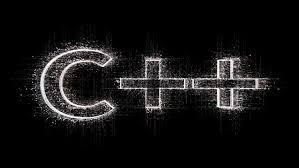C++ Tutorial For Beginners
Looking for a C++ tutorial?
Maybe you're new to the programming world and you were told to learn C++ first by either a friend or teacher.
Whatever your reason for being here, you've come to the right place.
This tutorial covers the basics of this programming language known as "C++" and it's designed for beginners and anyone looking to refresh their memory of the language.
So let's head straight in.
First of all,
What is C++?
C++ (short for “C-Plus-Plus”
or Cpp) is a middle-level programming language used mostly in game development
but can be used pretty much anywhere for various projects.
It is usually recommended by professionals as the first programming language to learn because it has all
the fundamental programming concepts embedded into it.
NOTE: C++; though related
to, is NOT C or C#. The difference
between them would be discussed later.
Next,
How/where do I
run a C++ program?
C++ is a compiled language and hence needs a program/software known as a compiler to first convert our C++ codes into
a language (usually binary) the computer can understand for execution.
There are various C++ compilers out there.
Some of them are:
· Apple C++. Xcode
· Bloodshed Dev-C++
· Clang C++
· Cygwin
· Mentor Graphics
· MINGW
· IBM
· GNU CC Source,
etc.
Then,
How do I write
C++ codes?
C++ codes are written inside C++ files.
These are basically text files with the “.cpp” file extension, which means that
you can use any text/code editor such as Notepad,
Notepad++, Sublime Text, Visual Studio
Code, Brackets, Bare Bones, Text Wrangler and Gedit
or an IDE (Integrated Development Environment) such as Code Blocks to create your C++ codes in a matter of minutes.
However, as mentioned earlier; a compiler is required to execute the codes
written so make sure you download a compiler (specifically a C++ compiler)
alongside your code editor or IDE.
C++ Setup
C++ is platform-independent,
which means it can run across a number of platforms such as Windows, Mac and
Linux.
The various setups for Windows and Mac
would be discussed next.
Mac and Linux have a similar setup structure and hence
you can use the Mac setup instructions on your Linux system.
Note that the setup is based on the Code Blocks IDE, however if you
have a favorite text/code editor already, you can stick with that. Just make
sure to download a C++ compiler before you get started.
Windows
Installation
1. Head on to www.codeblocks.org in your browser.
2. Click on “Downloads”.
3. Click on “Download the binary release”.
4. Click on the first
link. It should say “Windows XP/10/7/8” etc.
5. Click on the fourth link. It should say
“codeblocks-[version] mingw-setup.exe”. This setup installs Code Blocks AND
that C++ compiler we’ve been talking about.
6. Open up where you
saved the application and install it using the default settings.
7. Start using Code Blocks.
Mac Installation
1. Head on to www.codeblocks.org in your browser.
2. Click on “Downloads”.
3. Click on “Download the binary release”.
4. Click on the fourth link. It should say “Mac
OS X”. This should open up into another page.
5. Scroll to the bottom. You should see a zip
file and next to that, there would be a “Download from” table. Click on the
link there.
7. Extract Code Blocks application from the zip
file into your Downloads folder if it isn’t done automatically.
8. Drag and drop the
application onto your “Applications” folder.
9. Start using Code Blocks.
The next step is to get a C++ compiler.
Mac
computers usually come with a default C++ compiler and you can check to see if
you have that compiler by following the follow steps:
1) Click on the search bar on your desktop. It
should be at the top-right corner.
2) Type in “Terminal”
and open up the terminal window.
3) Type in “gcc -v” in the Terminal and hit
enter. If you have the compiler installed already, you should see “Configured with: ”
and some other information.
If you don’t see this, follow the next steps to
install it.
a. You can clear up the terminal window by typing
in “clear” and hitting “Enter” on the keyboard or leave it as it is, it’s up to
you.
b. Type “xcode-select --install” and hit enter.
If an error occurs, check to see if you have an internet connection and try
again.
c. Check if the compiler is properly installed by
following the steps above.
And you’ve successfully installed your
code editor and a C++ compiler. Now you’re ready to start programming in C++.
C++ Basics
In this section, we’ll deal
with all the basic concepts in C++. First of all, we’ll discuss the syntax of the language.
Syntax is basically the “grammar” of a
computer language.
For example, think of a human language (such as English or
Spanish). We have various grammatical rules for making sentences in English.
These rules, if followed, lead to easy communication between individuals. The
same goes for computers.
Computers cannot understand
human languages and although these languages are written in English, they are
translated into the binary representation of that language by either the
computer itself or with the aid of something called a “compiler”.
A compiler is a special software that translates
human-based codes of certain programming languages into a language the computer
can understand for execution.
C++ needs this special software so the computer
can understand the C++ commands as C++ is a compiled language as we mentioned
earlier.
So when we talk about syntax in C++, we’re
referring to the already-set rules in C++ with which a computer would use to
identify the language and carry out the tasks assigned.
| C++ Syntax |
C++’s syntax is very straight-forward and
easy to grasp. It can be divided into three smaller parts for easier
assimilation when working with variables.
These are the:
1. Type
Statement: This part tells C++ what kind of variable we’re working
with. This is necessary because C++ in addition to being a compiled language is
also a static language, which means that the type of a variable CANNOT be changed at runtime (when the
code is being executed). This basically means that if we set the type of a
variable to be string (text), we cannot put a number or any other value that’s not
a text.
2. Variable Naming: A variable can
be likened to a box. It’s where we store some value in the computer’s memory
for future use. The variable name is like a label we put on that box so we can
access the box later.
Imagine you’re moving from your current house to a new one.
You start packing your things into boxes right? Now imagine you don’t put
labels on the boxes. You’d have to open up EVERY box just to find where you
stored maybe your favorite comics.
This is why we use labels (or variable names)
so we can easily know that the box labeled “Comics” is where we stored all our
comics.
3. Value assignment: Since a variable
is just a box where we store information, we need to put in some actual stuff
in there. This is known as the value of
the variable. We can either assign a value to a variable on the same line
we declared it in by using an equal to sign (=) or we can assign a value later
when we need to make use of the variable.
Value/Data
Types In C++
So
now you know that we can store different values in variables but you might be
wandering, “what are the types of
these values or data that we store?”
There
are lots of value types we can store in variables. Some include:
· Characters: We can
use the “char” keyword before our variable name to tell C++ that we want to
store a single character in this
variable. This is done like so:

· Strings: Strings
are just a collection of different characters in a sequence. It can be likened
to plain text and we set the data type of this variable by using the “string”
keyword like so:
NOTE: When working with single
characters, we use single-quotes but when working with a sequence of characters
(a string); you can use either single or double-quotes.
· Numbers: Most
times in your programs, there’s going to arise a situation where we don’t want
to store text but a number;
either the age of a user or the rating the user gave us, etc. We can do this by
typing in the type of number we’re storing.
In C++, there are two basic number types. These are:
a) Integers: Popularly known as “ints”, these are
number types that are of whole numbers, e.g. the age of a person. These numbers
do not contain decimal figures.
b) Floating Point
Numbers: Popularly referred to as “floats” are numbers which contain decimal
figures, e.g. the rating of the user. Floats also have two distinct types which
are “floats” and “doubles”. The only difference between floats and doubles is
that a double can hold more decimal points than a float.
Declaring
value types of numbers can hence be done thus:
 |
| Integer Declaration |
 |
| Float Declaration |
 |
| Double Declaration |
NOTE:
- When working with
numbers, you don’t need to surround them with quotation marks. Quotation marks
are only necessary when working with strings and single characters.
- You can also store
negative numbers in these data types, like “-2”, etc.
- 20 and 20.0 are
regarded as different data types in C++. 20 is a whole number while 20.0 is a
floating point number.
c) Booleans: There’s
also another type of data value in C++ and in other programming languages which
is known as a “boolean”. A boolean is simply just a “true or false” data type. These
are usually used when we want to make certain decisions only when a particular
condition is either true or false.
To set a Boolean type for a variable, the “bool” keyword is
used like this:
The first condition asks if a user is a beginner in C++ and this
condition is set to true, which means the user is a beginner.
The second
condition asks if a user is not advanced in C++ (which if set to true would
mean that they’re
beginners) and this is set to false, which means they have some knowledge about
C++.
These true or false conditions can be helpful when writing
loops in C++.
Note the way the variables are named. The first letter of
the first word is in lowercase while the first letter of every other word is in
uppercase. This is known as “camelCaseNaming”.
A boolean can only have one of two conditions, true or false.
d) Arrays: Arrays are
a collection of multiple items, like names of students in a class, etc. Arrays
can have multiple values (or elements) and these elements can be accessed using
square brackets and typing in the index of the element we want like this: (cout
<< array[0] <<endl;).
Remember, you don’t always have to store information inside
a variable if you’re not going to reuse it.
For example instead of storing ‘A’
inside a variable and then printing it out, we can just print “A” out directly
like so:
Don’t worry too much about how this line came about. How to
write C++ codes would be discussed soon.
e) Void: In addition
to the above-stated types, there’s another value type in C++ and this is the
“void” value which essentially means nothing, or empty.
Download the full tutorial PDF here.






Comments
Post a Comment
Give us your feedback!